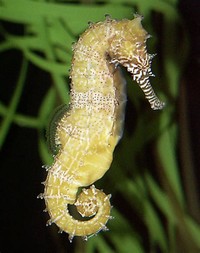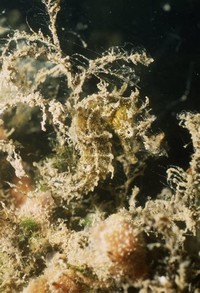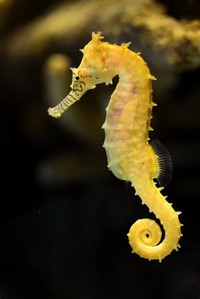Types of Seahorses

The Barbour's seahorse feeds on small shrimp, crustaceans, calanoid copepods and decapod larvae, but has also been known to ingest the larvae of polychaetes and fish. Individuals have well developed spines such as their sharp eye, nose, and double cheek spine.

The big-belly seahorse or pot-bellied seahorse, Hippocampus abdominalis, is one of the largest seahorse species in the world with a length of up to 35 cm, and is the largest in Australia. Seahorses are members of the family Syngnathidae, and are teleost fishes.

Find out what's known about Big-head Seahorses, Hippocampus grandiceps, Actinopterygii, Syngnathiformes, Syngnathidae, including their world range and habitats, feeding behaviors, life history, ecology, reproduction, and conservation status.

The bullneck seahorse (Hippocampus minotaur) is a pygmy seahorse in the genus Hippocampus. This seahorse has never been found in the wild, and little is known about its natural habitat. The only known specimens were collected on the coast of Eden, Australia.

The Knysna seahorse is a small, delicate creature with a standard length of up to 12 centimeters. Colouration is strongly influenced by the surrounding environment and a particular individual's mood. It varies from pale green to brown (often with darker speckles) to purplish black.

Hippocampus coronatus, commonly known as the high-crowned seahorse or crowned seahorse, is a species of fish of the family Syngnathidae. It is endemic to the Pacific coastal waters of Japan (found in shallow coastal waters from Tokyo bay and Sagami bay), where it lives among Zostera seagrasses.

Denise's pygmy seahorse is a small fish which can reach a maximum length of approximately 2.4 cm, which makes it one of the smallest representatives of the seahorses. This pygmy seahorse has a short snout, slender body with a prehensile tail.

The dwarf seahorse (Hippocampus zosterae) is a species of seahorse found in the subtidal aquatic beds of the Bahamas and parts of the United States. It is threatened by habitat loss. According to Guinness World Records, it is the slowest moving fish, with a top speed of about 5 feet (1.5 m) per hour.

Hippocampus fisheri, commonly known as Fisher's seahorse, or the Hawaiian seahorse, is a species of fish of the family Syngnathidae. It is known from the Hawaiian Islands, although previous misidentifications indicated species occurrences in Australia and New Caledonia.

The flat-faced seahorse, longnose seahorse, low-crowned seahorse or three-spot seahorse (Hippocampus trimaculatus) is a species of fish in the family Syngnathidae. It is found in Australia, Cocos (Keeling) Islands, French Polynesia, Hong Kong, India, Indonesia, Japan, the Philippines, Singapore, Taiwan, Thailand, and Vietnam.

The giraffe seahorse (Hippocampus camelopardalis) is a species of fish of the family Syngnathidae. It is found in coastal waters off of the south and east coasts of Africa, from South Africa to Tanzania, and possibly north to Kenya.

The great seahorse (Hippocampus kelloggi), also known as Kellogg’s seahorse, is a species of fish in the family Syngnathidae. It is one of the largest of the 54 species of seahorse.

The hedgehog seahorse (Hippocampus spinosissimus) is a species of fish of the family Syngnathidae. It inhabits coastal waters from India and Sri Lanka to Taiwan and northern Australia. It is threatened by overfishing, as both targeted catch and bycatch.

Hippocampus bargibanti Whitley, 1970 Hippocampus bargibanti, also known as Bargibant's seahorse or the pygmy seahorse, is a seahorse of the family Syngnathidae found in the central Indo-Pacific area.

The Japanese seahorse (in Japanese, kitano-umi-uma and sangotatsu) or lemur-tail seahorse (Hippocampus mohnikei) is a species of fish in the family Syngnathidae. The Japanese seahorse reaches a maximum length of 8.0 cm, is usually dark brown and has a relatively long tail, a ridgelike coronet and flattened spines.

Little is known about the specific biology of Jayakar’s seahorse, but seahorses in general exhibit a number of shared traits. The most extraordinary of these is the most extreme form of male parental care yet to be discovered .

The knobby seahorse, also known as the short-headed seahorse or short-snouted seahorse, is a species of marine fish of the family Syngnathidae. It inhabits coastal waters in southwestern and southeastern Australia, from Gregory to Bremer Bay, and from Denial Bay to Newcastle.

Lichtenstein's seahorse (Hippocampus lichtensteinii) is a species of fish in the family Syngnathidae.This species requires further investigation to ensure validity. ...

The long-snouted seahorse is a small-sized fish that can reach a maximum length of 21.5 cm but the average size is more or less 12 cm. The body is slender, the snout is long and the tail is prehensile.

Seahorses primarily eat larval shrimp and amphipods. Size. Longsnout seahorses typically range from 2 to 4 inches, with a maximum size of 6 inches. Range. Western Atlantic Ocean. Population Status. Vulnerable, as listed on the 2000 IUCN Red List . Predators. Longsnout seahorses have very few known predators due to their bony bodies and ability to camouflage.

The lined seahorse (Hippocampus erectus), northern seahorse or spotted seahorse, is a species of fish that belongs to the family Syngnathidae. H. erectus is a diurnal species with an approximate length of 15 centimeters (5.9 inches) and lifespan of one to four years.

Pacific Seahorse – Hippocampus ingens Introduction. The Pacific Seahorse is a well known species due to the wide areas it is found it. This is also one that is commercially grown so that it can be sold as pets. The chances of survival are better when that is the case so that they are bred with the right conditions.

A Guide to the Identification of Seahorses Sara A. Lourie, Sarah J. Foster, Ernest W. T. Cooper, and Amanda C. J. Vincent March 2004 Project Seahorse and TRAFFIC North America

Satomi’s pygmy seahorse is potentially the world’s smallest seahorse, and is hardly more than the size of a penny. The offspring of Satomi’s pygmy seahorse are each about the size of an apostrophe written in font size 12.

Seahorse (also written sea-horse and sea horse) is the name given to 54 species of small marine fishes in the genus Hippocampus. "Hippocampus" comes from the Ancient Greek word hippos (ἵππος, híppos) meaning "horse" and kampos (κάμπος, kámpos) meaning "sea monster".

Shiho's seahorse or painted seahorse (Hippocampus sindonis) is a species of fish in the family Syngnathidae. It is endemic to the Pacific coastal waters of Japan ...

The short-snouted seahorse (Hippocampus hippocampus) is a species of seahorse in the family Syngnathidae. It is endemic to the Mediterranean Sea and parts of the North Atlantic, particularly around Italy and the Canary Islands.

The spiny seahorse (Hippocampus histrix), also referred to as the thorny seahorse, is a marine fish belonging to the family Syngnathidae, native from the Indo-Pacific area.

The tiger snout seahorse or West Australian seahorse (Hippocampus subelongatus) is a species of fish in the family Syngnathidae. It is endemic to south-western Australia, where it occurs from the Abrolhos Islands to Rockingham.

Their habitat, subtidal aquatic beds and coral reefs, is threatened by climate change. Seahorses are also collected in large quantities for use in Chinese herbal medicine. Colors and Markings. Tigertail Seahorses are long black and yellow fish with long snouts, prehensile tails, and 16–19 pectoral fins.

The West African seahorse (Hippocampus algiricus) is a species of fish in the family Syngnathidae (Seahorses and pipefish). It is found in the eastern central Atlantic Ocean off Angola, Benin, Ivory Coast, Gambia, Ghana, Guinea, Liberia, Nigeria, São Tomé and Príncipe, Senegal, and Sierra Leone, as well as the Canary Islands.

White's Seahorse is a relatively common species in the Sydney area. It is commonly seen holding onto the nets of swimming enclosures. The species was named after named after John White, Surgeon General to the First Fleet.

The yellow seahorse has a carnivorous diet and feeds on small crustaceans and other planktonic organisms. It is ovoviviparous and it is the male who broods the eggs in its ventral brood pouch.

The zebra seahorse (Hippocampus zebra) is a species of fish in the family Syngnathidae. It is endemic to northern Australia. Habitat. This species of fish has been found inshore in and around coral reefs and it can also be found in areas with sand and mud bottoms, possibly associated with gorgonians. The maximum reported depth is 69 m..